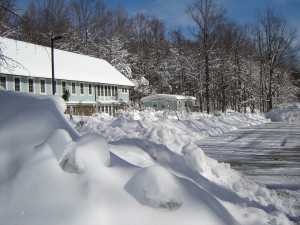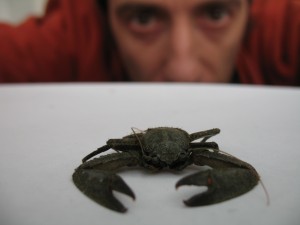by Monaca Noble
Remember Snowmageddon 2010, the east coast storms that dumped up to three feet of snow over the mid-Atlantic? The February snowstorm was the largest in the region in nearly 90 years, resulting in the heaviest snowfall on record for Delaware (26.5 inches) and the third heaviest snowfall in Baltimore (24.8 inches). The storm made a big impression on Dr. João Canning-Clode and other scientists at the Smithsonian Environmental Research Center, who began to wonder if the storm, and the December/January cold snap that preceded it, would lead to the deaths and potential disappearance of marine invaders from southern climates.Spurred on by the relatively recent increase in ocean surface temperatures, new marine invaders are beginning to spread northward along the southern and mid-Atlantic coasts from the Caribbean. This particular northern migration has been termed the “Caribbean Creep”, although the phenomenon of northward migration is not limited to that region. Many of the non-native species creeping northward are doing so because they are able to tolerate a wide range of temperatures. But what happens to these fair-weather travelers during a cold snap?
In January 2010 a cold snap in the southeast meant higher death rates for manatees, sea turtles, crocodiles and other high-profile species. But there was also evidence that Caribbean Creep invaders, like the Green Porcelain Crab (Petrolisthes armatus), had declined dramatically as a result of the January chill. Green Porcelain Crabs have a very large presumed native range that includes the tropical eastern Pacific from Mexico to Peru, the western Atlantic from the Gulf Coast of Florida to southern Brazil, and the eastern Atlantic from Senegal to Angola. But recently the crabs have moved north into Georgia and South Carolina.
To investigate further Dr. Canning-Clode and his colleagues experimentally tested the cold-water tolerances of green crabs in a study published in PLoS ONE. Introduced crabs collected in Georgia were brought to the lab, where they were subjected to one of three temperature treatments. The first was a control treatment, held at a constant, moderate winter temperature. The second was a cold treatment in which the temperature fluctuated to mimic the cold snap of January 2010. The third treatment tested extreme conditions, ones which would be expected in a more severe winter.
Most of the crabs in the control treatment survived (83%), but many of the crabs in the cold treatment (61%) and all of the crabs in the extreme cold treatment died. Those crabs that did survive the frigid waters were sluggish, making them more vulnerable to predators and possibly impacting their ability to feed. Prolonged exposure to cold temperatures may further jeopardize the crab’s ability to withstand future cold events, as two other record cold snaps occurred in February and March 2010. The loss of over 60% of the population each time could explain the disappearance of this species in Georgia, suggesting that extreme cold temperature events may limit or prevent the northward spread of the invasive Green Porcelain Crab.
Several climate models have predicted that climate change will lead to a continued decline of global biodiversity over the next 100 years and the increased spread of invasive species. Many of these models have focused on temperature increases, but few have evaluated the impact of severe weather like cold snaps. For example, several studies have reported mass die-offs of shallow-water marine invertebrates in the winter but have not linked these to climate change models. Dr. Canning-Clode and his collaborators suggest that these episodic cold weather snaps should be accounted for in future climate studies in aquatic environments.
“The core message of this paper is that yes, climate change is happening, but the cold is also part of this change,” says Dr. Canning-Clode. “We believe these periodic cold events will limit the range expansion of Petrolisthes armatus as well as other Caribbean creep species.”




I hope that climate change won’t lead to extinction of some of the endangered species. I think some serious preventive measures should be taken in order to protect the biodiversity on Earth.